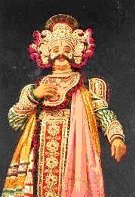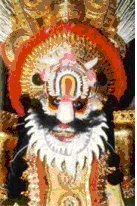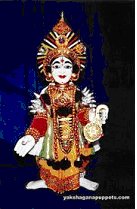 A Yakshagana artist wearing pagaDe, one type of head-wear. Among the head-wears pagaDe and kireeTa are worn by male characters and only small pagaDe by female ones. Exceptionally different head-wears are also used by commedians and some side roles.
A Yakshagana artist wearing pagaDe, one type of head-wear. Among the head-wears pagaDe and kireeTa are worn by male characters and only small pagaDe by female ones. Exceptionally different head-wears are also used by commedians and some side roles.all about yakshagana, yakshagana, yakshagana,
About Me

- Name: SaTiSh
- Location: India
i am satish from India. WELCOME to my blog, it contain jokes, facts, etc,. etc,. When living my page please don't forget to comment about my page at the end of the jokes or photos, and also join to guestbook.
Friday, November 17, 2006
 A Yakshagana artist wearing pagaDe, one type of head-wear. Among the head-wears pagaDe and kireeTa are worn by male characters and only small pagaDe by female ones. Exceptionally different head-wears are also used by commedians and some side roles.
A Yakshagana artist wearing pagaDe, one type of head-wear. Among the head-wears pagaDe and kireeTa are worn by male characters and only small pagaDe by female ones. Exceptionally different head-wears are also used by commedians and some side roles.The Word and the World, The Genesis, The Origin
Yakshagana is a traditional theatre form combining dance, music, spoken word, costume-makeup, and stage technique with a distinct style and form.
Both the word Yakshagana and its world are interesting and intriguing. It is a theatre form mainly prevalent in the coastal districts and adjacent areas, in Karnataka. It is closely connected with other forms prevailing in other parts of Karnataka, and its neighbouring states of Andhra Pradesh, Kerala, Tamilnadu and Maharastra.
Yakshagana, like many other forms, defies neat classification into categories like folk, classical, rural. It can be included into each of these, or all of them together, depending upon our line of approach. Being a theatre form, unlike a dance form, it is more plural and dynamic. And hence it exhibits many types and varieties inside itself. However, Yakshagana can be rightly called a traditional form.
The origin of any art form is in a way difficult to fix and the time and process of formation conceived is often arbitrary. As art forms grow over a period, and they include various elements from time to time and undergo many changes until they appear as we see them today. Theatre forms become solo performances (for example, Kathak) and may be vice versa.
The Origin
Basically Yakshagana is the product of the Vaishnava Bhakthi movement. Vaishnavism as a school of thought and religion is quite old. The Bhakthi movement proper, spread with vigour after the 10th Century. It took religion to the common man, to the lower strata of society, those classes to whom the highly formalised and Vedic religion was beyond reach. Hence Bhakthi movement was a social movement also.
In order to propagate and spread the message of devotion, it adopted and adapted the existing folk as well as classical literary forms and performances. It created its own forms. Most of the traditional theatre forms are the result of this phenomenon. Hence there are clear resemblance among the members of the 'Traditional Theatre Family' like Ankhia Nata (Assam), Jathra (Bengal), Chau (Bihar, Bengal), Prahlada Nata (Orissa), Veedhinatakam & Chindu (Andhra), Terukoothu Bhagawathamela (Tamil Nadu), Kathakkali (Kerala). Yet there are major differences also. Yakshagana is a member of this group and so its origin is connected with a wider historical situation.
Experts have placed the origin of Yakshagana from the 11th Century to the 16th Century. Earliest limit is fixed by a finding by Vidwan Bannanje Govindacharya who says a legend goes to show that Sage Narahari Thirtha (c, 1300) started a Dasavathara Ata performance and a troupe in Udupi and later this spread to other places and grew into what we call Yakshagana today.
Anyway, Yakshagana must have been an established form by the time of famous Yakshagana poet Parthisubba (1600) who wrote the Ramayana in Yakshagana. Because he is said to be a Bhagawatha (singer) himself and is believed to have founded a troupe, and probably he is the formulator of the Tenkuthittu (Southern style) of the art.
Growth and Changes, The Variations, The Troupes
With the socio-economic changes of the 19th Century, arts like Yakshagana also changed. The 19th Century produced a big number of compositions. Around 1800, a troupe from Dharmastala visited the court of the king of Mysore and established a troupe there. In the 1840s, a troupe from Uttara Kannada (North Kanara) visited Maharastra, and inspired the first modern age mythological drama by Vishudas Bhave. A number of troupes arose all over the Coastal Karnataka and probably in other parts of Karnataka too. By the early decades of this Century the structure of Yakshagana reached a definite shape and form.
1930s saw some changes in compositions, organisations and presentation. Dance and the spoken word was further developed and refined. But in costume, a type of degeneration started setting in due to the use of 'modern' clothing and stone jewellery, in place of handloom clothing and wooden ornaments.
The Year 1950 saw the birth of 'tent' troupes, giving performances to audience by tickets, with 'tent theatres' and furniture for seating. These troupes brought in commercialisation of Yakshagana, with both merits and demerits. Yakshagana saw major changes in form and organisation, electrical lights replaced the 'gas lights' or 'petromax' lamps. Seating arrangements improved. Major changes came in the themes, with the inclusion of folk epics, Sanskrit dramas and created (imaginary) stories forming the thematic base. Popular entertainment became the criterion in place of 'classical' presentation.
The North Kanara style of Yakshagana hitherto not know outside, started making a big impact on other styles. This trend continues even today.Along with all these, the traditional type of troupes, giving free shows financed by devotees still continue and have a very good support.
There are basically two variants of Yakshagana.
Tenkutittū
 The Tenkutittū style of Yakshagana
The Tenkutittū style of Yakshagana
The second variation, the Tenkutittū style, is prevalent in Southern areas of Tulu Nadu, that is, from Mulki to Kasargod.
The Troupes
Yakshagana is one of the most living art traditions in the World. There are about 30 full fledged professional troupes, and about 200 amateur troupes in Yakshagana. Professional troupes go on tour between November to May, giving about 180-200 shows that is, a full night show everyday!
There are about one thousand professional artists and much bigger number of amateurs. Further there are off season shows during the wet season, the anniversary shows, school and college students Yakshagana and of course the Talamaddale performances. All put together, we safely say that Karnataka witnesses about 12,000 Yakshagana performances every year!Yakshagana has not so far shown signs of quantity decline, in spite of very fast 'modernisation' and 'urbanisation'.
Yakshagana Puppetry
Another interesting facet of Yakshagana is the its use in puppetry. Evidence shows that there were more than 30 string puppet troupes in the undivided Dakshina Kannada district during the period 1910 – 1915 in places like Basrur, Barkur, Kokkarne, Mudabidri etc.
The puppetry in Yakshagana style is interesting as the presentation is highly stylized and adheres strictly to the norms and standards of Yakshagana. The puppets used are generally 18 inches high and the costumes are similar to those worn by the characters from Yakshagana with the same elaborate make-up, colourful head gear and heavy jewellery. The person who infuses life into the puppet and makes it come alive, by dextrous manipulation is known as the Suthradhara. The content in the Yakshagana puppetry, is drawn heavily from the ancient epics.
===================
Want fun then why wait? Click on any one of URLhttp://blog4people.coz.in http://jokes4children.coz.in http://adsense.coz.in http://kannada.coz.in http://ourmysore.coz.in http://wowbangalore.coz.in http://wowchennai.coz.in http://bhshistory.coz.in http://karaga.coz.in
Background of Yakshagana Puppetry, Training and Research, External links
Background of Yakshagana Puppetry
Though Yakshagana puppetry had existed since a long time, it was moulded by Laxman, Narasimha and Manjappa Kamath, hailing from Uppinakudru village in Kundapur taluk. Devanna Padmanabha Kamath, the grand son of Laxman Kamath infused new life into it and performed shows all over India. Currently, his son Kogga Kamath is at the forefront, performing shows and training youngesters in Yakshagana puppetry.
Training and Research
Training schools for Yaskhagana are very few in Coastal Karnataka. As most troupes are associated with temples, the training has been confined to the temple premises. However, the Govinda Pai Research Institute, located at MGM College, Udupi, runs a Yakshagana Kalakendra in Udupi that trains youngsters in this ancient dance form. The Govinda Pai Research Institute does research work on language, rituals and dance art forms of Tulu Nadu.
External linksTuesday, November 07, 2006
Welcome Invitation!

Want more fun then why wait? Click on any one of URL
http://blog4people.coz.in http://jokes4children.coz.in http://adsense.coz.in http://kannada.coz.in http://ourmysore.coz.in http://wowbangalore.coz.in http://wowchennai.coz.in http://bhshistory.coz.inhttp://karaga.coz.in http://safeeyes.coz.in


